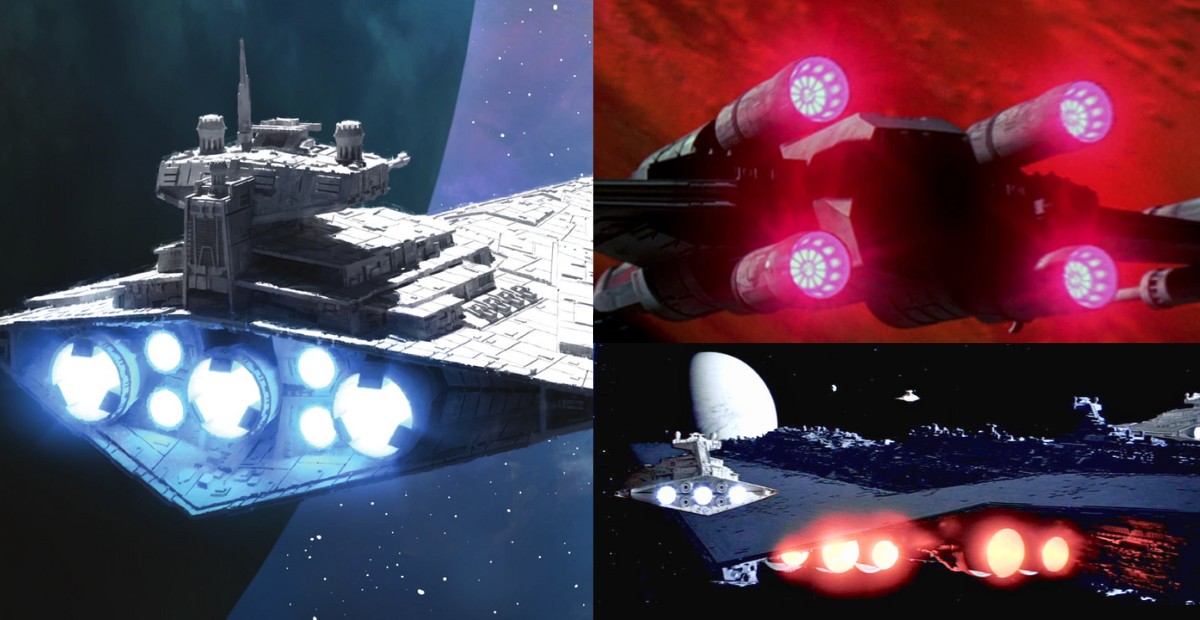You ever notice how starship engines in Star Wars glow in all sorts of colors?
Sometimes they’re red or orange, other times a bright blue, and every now and then you get a flash of yellow or gold.
I’ve always wondered if there’s some deeper reason behind these color choices – like, to differentiate the sides or just the filmmakers wanting them to look cool?
Let’s get into and see what might actually be going on here.
Fuel Types and Engine Designs
One of the first things I thought of is fuel and engine type. It makes sense that in Star Wars, different factions and ships might use different fuels and engine tech, and that would affect what we see on screen.
For example, the Empire’s got money and access to advanced tech, so their big ships like the Victory I-Class Star Destroyer burn blue, thanks to what’s probably top-tier ion propulsion.
The Rebel Alliance? Not so much. They rely on whatever fuel they can pull together, so we often see red or orange exhausts on their ships – like the good old X-wing.
This actually lines up with real-world science. Different chemicals glow different colors when burned.
Like in real life, where xenon burns blue when it’s ionized (which is a thing with real ion thrusters), different fuels in Star Wars could lead to different exhaust colors.
So with the Empire, I picture those advanced ion engines with some premium fuel that makes a blue glow, while the Rebels’ engines give off that red or orange glow, showing their resourcefulness.
More Power, More Blue
There’s also the idea that the color might have to do with engine power and temperature. You’ve probably heard that hotter fire glows blue while cooler stuff glows red.
So in Star Wars, the bigger ships, like those Victory I-Class Star Destroyers, might glow blue because they need a ton of power to push their massive frames around in space.
Smaller ships, like the X-wings, just don’t need that same level of thrust, so they run a bit cooler, resulting in red or orange exhaust.
Then there’s the Executor – Darth Vader’s flagship, with its yellow-glowing engines.
Whether it’s because of some special tech or maybe even just design flair, that gold glow tells you right away that this ship is different.
Color as Storytelling and Faction Identification
One big reason for the color differences in Star Wars engines is that it helps us tell the factions apart and adds to the storytelling.
In chaotic battle scenes, color-coding makes it easy to know who’s who. The Empire generally has blue engines (like on their Victory I-Class Star Destroyers) and green blasters, while the Rebels stick with red or orange engines (like on X-wings) and red blasters.
This choice was inspired by WWII tracer rounds, where different colors helped soldiers recognize friend from foe in battle.
Star Wars does something similar: these colors guide our eyes and make it easier to follow the action, even if we don’t realize it.
And color in Star Wars always carries a bit of symbolism. Red almost always signals danger, the dark side, or the Empire, while blue and green are tied more to heroes or the Jedi.
Engine colors don’t carry the same weight as lightsabers, but they still contribute to the overall visual language.
The Empire’s sleek blue exhaust fits its high-tech, powerful image, while the Rebel’s red or orange glow reinforces their scrappy, resourceful nature.
So, while color choices might seem small, they’re essential to Star Wars’ visual storytelling, helping us quickly identify the “good guys” and “bad guys” and stay grounded in the scene.
Sometimes, It’s Just About Looking Cool
Let’s be real – a huge part of the color choices in Star Wars comes down to what looks cool. George Lucas and the team didn’t always aim for scientific accuracy.
They wanted these scenes to be iconic, memorable, and visually striking.
Think about it: a bright blue exhaust against the darkness of space, the fiery red of a Rebel fighter, or the golden glow of the Executor. It’s all meant to look amazing.
This “rule of cool” lets them play with colors to keep each scene visually exciting. It’s not really about realism; it’s about making Star Wars look and feel larger-than-life.
I mean, what’s Star Wars without those incredible visuals?

